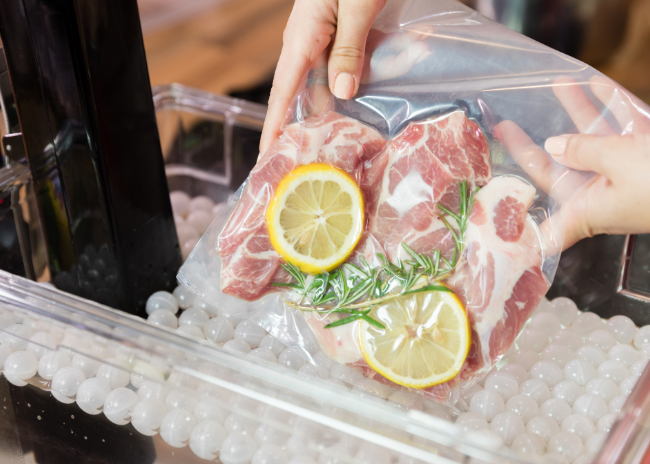While the pandemic and restaurant restrictions has made it challenging to pinpoint food trends this New Year, one pattern certainly stands out.
 Karen Malody“People are looking for ‘comfortine’ foods,” says Karen Malody, FCSI, founder/president, Culinary Options LLC. A play on the word quarantine, she’s quick to differentiate “comfortine” from “comfort foods,” the latter of which signal items like macaroni and cheese, and pizza. Rather, Malody has seen a growth in popularity of slow-cooked, deep and rich dishes like stews, pot roasts, smoked meats and barbecue. What’s more, these foods have proven to travel well during the takeout fever that marked 2020 and continued into 2021.
Karen Malody“People are looking for ‘comfortine’ foods,” says Karen Malody, FCSI, founder/president, Culinary Options LLC. A play on the word quarantine, she’s quick to differentiate “comfortine” from “comfort foods,” the latter of which signal items like macaroni and cheese, and pizza. Rather, Malody has seen a growth in popularity of slow-cooked, deep and rich dishes like stews, pot roasts, smoked meats and barbecue. What’s more, these foods have proven to travel well during the takeout fever that marked 2020 and continued into 2021.
“I describe comfortine foods as those with many deep flavors and textures that melt in your mouth and make you feel good eating while them — dishes like birria (a rice dish with spices, meat, eggs and vegetables), posole, mole, West African stews and other stews across all global cuisines, and even regional American cuisines like the different styles of barbecue,” Malody says. “The affordability factor is certainly there, for both the operator and the consumer, and the ‘transportability’ of these foods is key.”
Indeed, restaurant consultancy Andrew Freeman & Co., which releases a yearly trends report, pointed to quesabirria, a tortilla topped with cheese and a Mexican stew traditionally made with goat, as the top food trend for 2021 because it is “comforting, made from inexpensive ingredients and [is] a mashup of tastes,” according to the firm’s report. Regional Indian is expected to prove popular this year as well, led by comfortine dishes like biryani. Even third-party research firm Datassential points out that consumers continue to turn toward Mexican food, seafood and Asian dishes that provide comfort. For example, 71% of Gen Z consumers said they crave ramen in a study conducted last fall.
Malody points out that these foods already have a direct impact on equipment selection and usage, and will continue to do so in the future. Here are six notable food trends impacting equipment.
 1. Sous Vide
1. Sous Vide
“I think sous vide is going to explode,” says Malody. Sous vide cooking was gaining in popularity before the pandemic, she notes, thanks to its “set-it-and-forget-it” style and penchant for consistency. “Many chefs have discovered that it can help operators keep up with the food production faster without degradation of quality,” she says.
The other advantage of sous vide cooking is the ability to infuse more flavors into food. “You can really add more marination and infuse more ingredients into less costly pieces of meat and other proteins in those sous vide bags, and then just do some quick finishing on a grill or speed-cook oven,” she says. “The advantage is lower cost food, less labor, deeper flavors, sometimes a better-quality product, consistency and speed of service.” What’s more, Malody adds, “you can extend shelf life because food is already in airtight packaging.” Rather than produce food each day, sous vide equipment makes it possible for operators to produce large batches of individually sealed items they can store for quick finishing later.
2. Mini Cook-Chill
Along those lines of storage, Malody says she also sees more operators — and not just large-scale institutional operators — investing in cook-chill systems, albeit on a smaller scale. “This goes hand-in-hand with sous vide,” she says. “Whether the food is cooked sous vide or slow-cooked overnight, the food can then be blast chilled at the end of the cycle for longer keeping.”
In the past, Malody says, “people thought cook-chill was just for huge hospitals or for when you’re feeding thousands of people, but now more operators are realizing the benefits of blast chilling to preserve consistency and quality.”
3. Better Hot-Holding
Malody sees an expansion of hot-holding equipment and systems to allow operators to cook in larger batches and speed up production, but hold food safely while maintaining quality before service. “People cannot produce food for the customer fast enough with all these points of distribution, like takeout and delivery, so they are finding that many foods can be held in well-humidified, hot-holding for longer periods of time with no degradation of quality at all,” she says. “I’m seeing more and more of these hot-holding units being used in back kitchens and in ghost kitchen lines, without having to be out in front of the customer.
Hot-holding might also find its way into the delivery/food locker/pickup scene. “I am seeing more temperature- and humidity-controlled lockers being used for holding food for pickup,” says Malody, adding that whoever figures out how to put that technology onto delivery trucks and vehicles is really going to capture that competitive edge. “We need miniature hot-holding units that can run on battery for 12 hours used in just about any application.”
4. Pressurized Tilt Skillets
Like the commercial version of an Instapot, more operators show interest in pressurized tilt skillets to speed up stew-type cooking and “achieve deep flavors and tenderization in a faster cooking environment,” Malody says. “I wouldn’t be surprised if in five years all tilt skillets had some sort of pressurized technology.”
What this industry has needed for a long time is an industrial crockpot, as Malody describes it. Again, it’s all about equipment that can support that slow-cooking methodology, whether an operator cooks 100 pounds or 10 pounds – the results are and should be the same.
5. Marination Tumblers
Again with the “deep flavor infusion,” Malody sees growing interest in marination tumblers, once reserved just for food production companies or some barbecue restaurants. “You can toss foods in these tumblers and infuse deep flavors without having to hold proteins in big vats of liquid for a day or two in the walk-in,” she says. “No one has the time or space for that anymore.”
While underutilized in the past in commercial foodservice, with continuing smaller spaces and kitchens, these machines remove air from the barrel to pull moisture and infuse flavors in the food’s core. The tumbling or flipping technology, Malody says, helps “massage” the marinades into the meat.
6. Smokers and Barbecue Equipment
Of course, barbecue equipment in the form of smokers and wood-fired cooking equipment has a place in the slow-cooked, deep flavor realm. Once reserved for barbecue-specific restaurants and those with exceptional HVAC and fire suppression systems, smokers are being scaled down for use in just about any and all kitchens.
A lot of the newer, multiuse equipment on the market, and some combi-ovens, have smoke boxes or smoking capabilities. “Not only can you slow-cook or steam, but you can also smoke food in them … and that’s huge,” Malody says.
While food trends and even the future of the foodservice landscape continues to remain uncertain as we continue through a new year, one thing is for certain, Malody notes, “the way food and equipment are so intertwined” will never go away.




